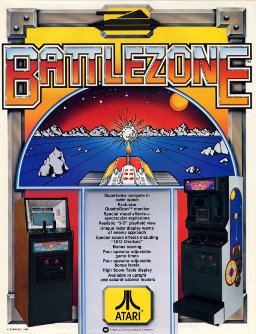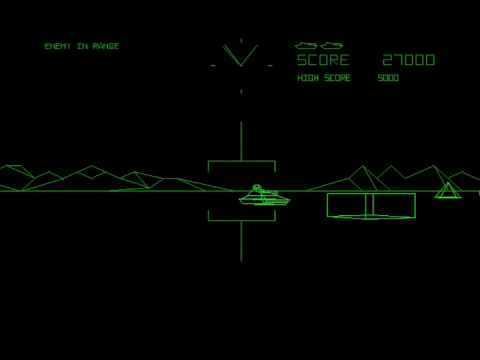8.8 /10 1 Votes8.8
CPU 6502 Cabinet Video game arcade cabinet Designers Owen Rubin, Ed Rotberg | 4.4/5 My Abandonware Mode(s) Single player Initial release date November 1980 Developers Atari, Atari, Inc. | |||||||||||||||||||||||||||||||||
 | ||||||||||||||||||||||||||||||||||
Release date(s) ArcadeNovember 1980Atari 2600NA: 1983EU: 1983 Genre(s) Combat simulation, Vehicular combat Sound POKEY and discrete circuits Similar Battlezone games, Atari games, Strategy video games | ||||||||||||||||||||||||||||||||||
Battlezone is a first-person tank combat arcade game from Atari released in November 1980. The player controls a tank which is attacked by other tanks and missiles. The game uses wireframe vector graphics on a black and white (with green and red sectioned color overlay) vector monitor. It was designed primarily by Ed Rotberg, who designed many games for Atari Inc., Atari Games, and Sente.
Contents

Gameplay

Gameplay is on a plane with a mountainous horizon featuring an erupting volcano, distant crescent moon, and various geometric solids (in vector outline) like pyramids and blocks. The player views the screen, which includes an overhead radar view to find and destroy the rather slow tanks, or the faster moving supertanks. Saucer-shaped UFOs and guided missiles occasionally appear for a bonus opportunity. The saucers differ from the tanks in that they do not fire upon the player, and do not appear on radar. The player can hide behind the solids or maneuver in rapid turns once fired on to buy time with which to fire himself.

No additional tanks are awarded until the score counter rolls over at ten million, and additional bonus tanks are again awarded at indicated scores of 15,000 and 100,000. The game only includes one hostile enemy on the game board at all times; the player never has to battle two enemy tanks at once, or a tank and guided missile. The UFO can appear on the screen at the same time as an enemy tank, and it can occasionally be destroyed by enemy fire.

The geometric solid obstacles are indestructible, and can block the movement of a player's tank. However, they are also useful as shields as they block enemy fire as well.

The music heard when a score of 100,000 is attained and in the high score initials prompt is from Tchaikovsky's 1812 Overture.
Cabinet
Battlezone was housed in a standard upright arcade cabinet with a novel "periscope" viewfinder which the player used to view the game. The game action could also be viewed from the sides of the viewfinder for spectators to watch. A later, less common version of the cabinet removed the periscope to improve visibility to non-players and improve the ergonomics for players who could not reach the periscope. This modification also was welcomed by some operators, who felt that the small windows present in the "periscoped" version did not attract enough attention to the game when played.
A smaller version of the cabinet (known as a "cabaret cabinet") also existed with the screen angled upwards, and no periscope. A cocktail table version was tested as a prototype but not produced; it lacked the color overlays as the display would have to flip for opposing players.
The controls consisted of left and right joysticks, which could only be moved in the Y (vertical) axis, each controlling the treads on that side of the player's tank. One joystick contained a button used to fire projectiles at enemy targets.
The Bradley Trainer
A version called The Bradley Trainer (also known as Army Battlezone or Military Battlezone) was also designed for use by the U.S. Army as targeting training for gunners on the Bradley Fighting Vehicle. Approaching Atari in December 1980, some developers within Atari refused to work on the project because of its association with the Army, most notably original Battlezone programmer Ed Rotberg. Rotberg only came on board after he was promised by management that he would never be asked to do anything with the military in the future. Only two were produced; one was delivered to the Army and is presumed lost, and the other is in the private collection of Scott Evans, who found it by a dumpster in the rear parking lot at Midway Games. The gunner yoke was based on the Bradley Fighting Vehicle control and was later re-used in the popular Star Wars game. The Bradley Trainer differs dramatically from the original Battlezone as it features helicopters, missiles, and machine guns; furthermore, the actual tank does not move—the guns simply rotate.
Legacy
Because of its use of first-person pseudo 3D graphics combined with a "viewing goggle" that the player puts his or her face into, Battlezone is sometimes considered the first virtual reality arcade game.
Pandemic Studios developed an authorized Battlezone game, published by Activision in 1998. Despite having the same name, it is not an arcade game, but a more complicated tank piloting strategy game. Battlezone II: Combat Commander is the 1999 sequel.
A re-imagining of Battlezone was developed by Paradigm Entertainment and released for the PlayStation Portable.
On April 16, 2008 an updated version of Battlezone was released on Xbox Live Arcade. The game was developed by Stainless Games and published by Atari Inc. It features 1080i graphics, Dolby 5.1 audio and an online mode to play against 2 - 4 friends in Deathmatch and Capture the Flag modes, and incorporates Xbox Live Vision support.
In July, 2013, Rebellion Developments bought the Battlezone franchise from the Atari bankruptcy proceedings. On October 13, 2016, they plan to release a remake of the original Battlezone on PlayStation 4 for PlayStation VR, and on Steam for the Oculus Rift and HTC Vive.
Ports
Throughout the 1980s, Battlezone was ported to several home computer systems (usually on the Atarisoft label), including the IBM PC 5150, the Apple II, the Commodore 64, the Sinclair ZX Spectrum, and the Atari XEGS. The Atari ST port contains large parts of the original 6502 code which is emulated in real time.
An Atari 2600 port was also released, but has colored raster graphics due to limitations and the view is behind the tank rather than inside it.
An Atari 5200 port was in the works, scheduled for release in November 1983, but was cancelled.
The Atari Lynx had the deluxe port Battlezone 2000 (within that version is a hidden game with scaled sprites instead of vector graphics).
A Game Boy port was made which included a port of Breakout.
Clones
Stellar 7, a Battlezone-inspired game, was released for the Apple II and Commodore 64 in 1983.
Robot Tank, released by Activision in 1983 for the Atari 2600, is similar to the Atari 2600 version of Battlezone.
A clone named 3D Tank Zone was released on the Acorn Electron and BBC Micro in 1983 by Dynabyte.
3D Tank Duel and Rommel's Revenge by Realtime Games and Crystal Computing respectively were released for the Sinclair Spectrum in 1983 and 1984, shortly before the Atari-authorized version was released by Quicksilva.
Encounter (1984) for the Atari 8-bit computers and Commodore 64 is similar in design to the Atari 2600 version of Battlezone. It includes both the missiles and saucers of the original.
A TRS-80 Color Computer clone is called Rommel 3D and was released in 1985.
A Battlezone clone for Apollo Domain/OS called bzone was written by Justin S. Revenaugh in 1986 and re-written for the X Window System by Todd Mummert in 1990. The X Window System version, cbzone, differed from the original arcade version in that the player could be attacked by more than one enemy tank at the same time. This version of the game was also ported to the Macintosh in the 1990s and was included in the UMich software archive.
Another clone from Design Design software called Tank Busters was released in the mid-80s for the Amstrad CPC.
The 1991 Macintosh tank game Spectre and its sequels owe much to Battlezone for their gameplay and appearance.
The SGI workstations had a Battlezone derived game in the early 1990s called BZ which added network play. BZ also had guided missiles, where the player would fly the missile after launch, returning to the tank on impact. This version evolved into the game BZFlag with a 'capture-the-flag' mode where flags can change the tank's abilities.
Reception
Battlezone was well received, earning an Honorable Mention for "Best Commercial Arcade Game" in 1982 at the Third Annual Arkie Awards.
